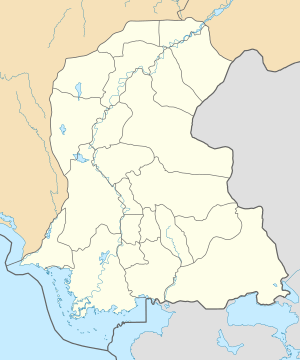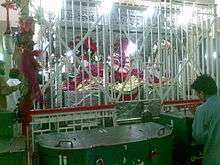Sehwan Sharif
| Sehwan سیہون | |
|---|---|
| Town | |
 The Shrine of Lal Shahbaz Qalandar in Sehwan Sharif | |
 Sehwan | |
| Coordinates: 26°25′10″N 67°51′34″E / 26.4193143°N 67.8593731°ECoordinates: 26°25′10″N 67°51′34″E / 26.4193143°N 67.8593731°E | |
| Country |
|
| Province | Sindh |
| District | Jamshoro |
| Population | |
| • Estimate () | over 100,000 |
| Time zone | UTC+5 (PST) |
| Calling code | 76140 |
Sehwan (Sindhi: سيوهڻ شريف, Urdu: سیہون; also commonly referred to as Sehwan Sharif or Noble Sehwan) is a historic city located in Jamshoro District of Sindh province in Pakistan and is situated on the west bank of the Indus 80 miles (130 km) north-west of Hyderabad. The city is renowned for being home of one of Pakistan's most important Sufi shrines, the Shrine of Lal Shahbaz Qalandar.
Due to the popularity of its Sufi shrine, the terms "Sehwan" and "Qalandar" are often used interchangeably in Pakistan. Sehwan is one of Pakistan's most important spiritual centres, along with other shrines such as the Shrine of Abdullah Shah Ghazi in Karachi, Data Durbar Complex in Lahore, Bari Imam in Noorpur Shehan near Islamabad, and the lustrous tombs of the Suhrawardi sufis in Multan.[1]
History
It is possible that the name Sehwan originates from Sewistan[2] or Sheestan, attributed to the prophet Shees or Seth, the third son of Adam and Eve. Others say that its name originated from "Siwistan" or "Shiv-istan", the kingdom of Raja Dahir which extended to the Punjab.[3] It was conquered by Muhammad bin Qasim in 711, and two centuries later by Mahmud of Ghazni. An abortive attempt was made by the Mughal emperor Humayun to capture it on his way to Umarkot but it finally fell to his son Akbar. Before this, it was the capital of the Thatta Kingdom under Juni Bek.[4]

The city is known for its Sufi patron saint Lal Shahbaz Qalandar who lived there in the 13th century.
The Shrine of Lal Shahbaz Qalandar attracts hundreds of thousands of visitors every year. Shrine of the famous sufi saint Hazrat Murshid Syed Nadir Ali Shah, a notable "Sajjada Nashin" or spiritual successor[5] of Hazrat Lal Shahbaz Qalandar is also located in Sehwan, where a large number of people are served free meals round the clock.[6] Another famous place is the inverted city.[7] Manchar Lake, the largest freshwater lake in Pakistan, which is at a short distance from Sehwan Sharif.[8]
Incident
On the 16th of February 2017, a suicide bomber triggered an explosion at the Shrine of Lal Shahbaz Qalandar, killing at least 83 people and injuring almost 250. The attack occurred during a praying session. The bombing took place at an 800 year old Shrine.[9][10]
See also
References
- ↑ Akhtar, Suleman (22 February 2017). "Damadam mast Qalandar is a cry of rebellion against established orders". Dawn. Retrieved 22 February 2017.
- ↑ ":: NasarPur.Com ::". nasarpur.com. Retrieved 2018-03-04.
- ↑ P. 150, Introduction To Political Science: Political Theory By R.C. Aggarwal.
- ↑ John F. Richards, The New Cambridge History of India: The Mughal Empire (New York: Cambridge University Press, 19930 p. 51
- ↑ William., Donkin, (2000). The wayfarers : an account of the work of Meher Baba with the God-intoxicated and also with advanced souls, sadhus, and the poor ; fully illustrated with many photographs and maps. North Myrtle Beach: Sheriar Foundation. ISBN 9781880619247. OCLC 55735757.
- ↑ Correspondent, The Newspaper's (2014-06-18). "Qalandar Urs celebrations get under way". DAWN.COM. Retrieved 2018-02-04.
- ↑ Soomro, Farooq (2014-10-10). "Sehwan: The undisputed throne of Lal Shahbaz Qalandar". DAWN.COM. Retrieved 2018-02-23.
- ↑ "Lake Manchar – A Perfect Holiday Destination". Sindhi Dunya. 2015-09-14. Retrieved 2018-02-23.
- ↑ CNN, Ray Sanchez, Sophia Saifi and Adeel Raja. "At least 75 killed in suicide attack at Pakistani shrine". CNN. Retrieved 2017-02-21.
- ↑ "Blast hits Pakistan's Lal Shahbaz Qalandar Sufi shrine". www.aljazeera.com.
| Wikivoyage has a travel guide for Sehwan. |